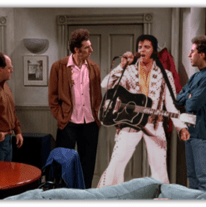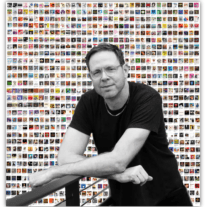As I wrote about previously (here🙂
and here:
…the earliest works of electronic music were mostly impenetrable avant garde experiments.
So, what about more accessible electronic tunes? Who were the early ancestors of synth pop?
Let’s find out!
In 1954, Raymond Scott recorded his first piece of electronic music, using an instrument of his own design.
This track, “The Rhythm Modulator,” consists of sequenced bleeps and bloops alongside Scott’s spoken announcements of each new sequence variation (“Alright, this is Number Two.” “This is Three”).
The track is experimental in nature. As in, literally developed in a laboratory.

It was made to showcase a new instrument, one of several inventions developed in Scott’s lab, Manhattan Research Inc.
“The Rhythm Modulator” was the first recorded example of automatically sequenced electronic music. This was the start of Scott’s foray into sonic wizardry.
However, it was by no means Raymond Scott’s first foray into writing and recording music.
In the 1930s, he had enjoyed success as a novelty composer.


And in the 1950s, he served as orchestra leader for the CBS television show Your Hit Parade, a lucrative gig that helped him fund his experiments at Manhattan Research Inc.
Scott treated his compositions seriously as bold and exciting new musical territory, yet most of his work is infused with playfulness and humor. He was never above being an entertainer, or selling products to make a buck.
Around this time, there was no commercial market for electronic music.
Yet there were some opportunities that began to emerge for innovative knob twiddlers such as Scott.
In 1958, Phil Spector produced his first Number One hit, featuring what would become his calling card of striking sound production.

Spector’s subsequent hits with the Crystals, the Ronettes, and Darlene Love, among others, would eventually create an appetite for innovative sound engineering in pop music.
That same year, several novelty songs featuring sped-up vocal recordings topped the Billboard charts. It seemed that young listeners were hungry for out-there sounds and textures that traditional performances couldn’t provide. Raymond Scott himself tried his hand at such novelties a few years later, and did not strike gold.

Hmmm…I wonder why this never caught on…
Alas, it would be another decade before an electronic ditty had any real commercial success on the charts. It would take some time for the artistic world to catch up to the innovators.

Including “Lightworks.” I don’t know what the heck kind of product Lightworks was, but the jingle is an early synth pop classic!
Another venture was his 1962 series of albums designed to entertain, stimulate, and soothe babies, relying on psychoacoustic research on infants to inform his compositions.

Throughout the 1960s, Scott would continue to push electronic music forward.
He gave us the Clavivox, which was a keyboard-based instrument that emulated the voicelike sounds of the theremin.

And then the Bass Line Generator, the first synthesizer dedicated to creating different bass sounds.
Despite the names, Scott’s intention was not to merely imitate conventional instruments. He created these devices to materialize the various sounds in his head like no live musicians could do.
As important as Raymond Scott was to the birth of electronic pop, he wasn’t the only mad scientist around at this time.

- Robert Moog worked in Scott’s lab, and he later became legendary for creating his own line of modular analog synthesizers.

- Jazz producer Joe Meek released an album of “outer space music fantasy” in 1960, featuring some delightfully weird electroacoustic experimentation.
- Dick Hyman was a jazz pianist and keyboardist whose work in the early 60’s sometimes relied on spacey electronic sounds.

Most importantly, there were the Dutch composers Dick Raaijmaakers and Tom Dissevelt (aka “Kid Baltan”), who were researchers in a Phillips audio lab.

In 1963, they released the fruits of their experiments, including this 1956 ditty, “Songs of the Second Moon.”
Recorded with an Ondes Martenot and their own treatments, “Second Moon” bounces around with a playful melody before shifting to a more anthemic feel. While most early synth work retained some debt to jazz pop, the Dutch duo made spacey instrumentals that sounded quite similar to synth pop from the late 1970s.
Also in 1963, families all over England were tuning into Dr. Who, and hearing its distinctive electronic theme, arranged and recorded by an in-house whiz of the BBC’s Radiophonic Workshop, Delia Derbyshire.

Dr. Derbyshire later recorded some tracks with pop singer Anthony Newley, and they sound like proto-industrial novelty tunes.
A few years later, Gershon Kingsley and Jean-Jacques Perrey would release an album of what can only be called synth-pop, albeit still of the novelty variety. These songs didn’t chart well, but Kingsley’s later tune “Popcorn” would get to #9 on the Billboard charts. The pop market was finally ready for the future.
Unfortunately, Scott himself never got to taste real success from his electronic work. Most of his time and money was spent trying to realize his most ambitious project: the Electronium.

This was the first generative synthesizer: meaning it could generate original harmonies and melodies automatically via algorithm, with minimal input.
Scott managed to sell his Electronium to Berry Gordy of Motown Records, and he served as director of Motown’s electronic music department from 1971 to 1977. But Scott’s perfectionism ultimately kept him from ever finalizing the machine–he continued to tinker and improve until Motown lost interest.
Scott dedicated a decade of his life and hundreds of thousands of dollars toward the Electronium’s completion. But in the end, the machine was never finished according to his standards. His waning health and eventual death prevented him from ever doing so.

Incidentally, the machine is currently owned by Devo singer Mark Mothersbaugh, who is dedicated to repairing it and completing the project.
So began the early development of synth pop as a form of music. Starting from technological experiments, it moved on to commercial obscurities, and then to successful pop novelties. These early templates would subsequently capture the imaginations of a new generation of musicians.

The new class would take pop music further into uncharted sonic territory, and become global sensations in the process.
Even later, electronic tunes would become cheap and quite easy to make, as music hardware and software would continue to improve.
Raymond Scott may never have finished a generative synthesizer that conformed to his high standard of excellence, but his contributions to electronic music were highly generative in their own right.
Inventors inspired by him and the other mad scientists of synthetic pop eventually made manifest the impossible feats that those original geniuses had all dreamed of.
Hopefully future sequences in this collective composition will render modulations as novel and exciting as those that came before.

This post was inspired and informed by Stan Warnow’s documentary about his father “Deconstructing Dad: The Music, Machines, and Mystery of Raymond Scott.”
Let the author know that you liked their article with a “Green Thumb” Upvote!





Have of those beats from “The Rhythm Modulator” been sampled in Hip Hop songs? Seems like they’d work pretty well.
I didn’t know Delia Derbyshire and Anthony Newley performed together. That’s as good a combination as Nancy Sinatra and Lee Greenwood. Bizarre and interesting.
Good work as always, Phylum!
The safe answer is…probably?
I know a few people have sampled his “Light Works,” (which I forgot to include a link to):
https://www.youtube.com/watch?v=rWbzAa_c1VY
This is fascinating territory and you highlighted some really interesting stuff.
I would also like to add Max Crook’s name into the mix. He developed a monophonic synth in 1959 that he called a musitron and first recorded it on a track with Berry Gordy that went unreleased. It eventually showed up two years later famously on Del Shannon’s “Runaway”, as Crook was the keyboardist in the band and helped write the song. Many artists drew inspiration from the musitron in future dalliances with electronic sounds.
The actual track “I Hear a New World” by Joe Meek has to be heard to be believed. I think he and it would be more recognized had he not ended his life in a murder-suicide.
I didn’t know about Max Crook, but I’m thoroughly enjoying “The Snake.” Thanks for the info!
Great stuff, informative and entertaining as ever. I know some of the names and the Dr Who theme is ingrained into me. I’m sure they were still using the original version in the 80s when I was watching it.
There’s a lot more that I didn’t know and some of these early works are far out. Not surprising it took a while to enter the mainstream. Like Bill, I had no idea about Delia Derbyshire and Anthony Newley working together. Just reading up on it and says Delia spent 64.5 hours working on the music. For something that sounds so simple it shows how primitive the equipment must have been.
I’ve got some Newley when my novelty series gets to the 60s but this is way beyond that. I don’t know if he just had a low boredom threshold but he made some interesting career choices.
Who woulda thunk that Newley would have set an early template for Genesis P-Orridge’s creepy vocal style?
Maybe he had to out-weird David Bowie, who had been aping him the year before.